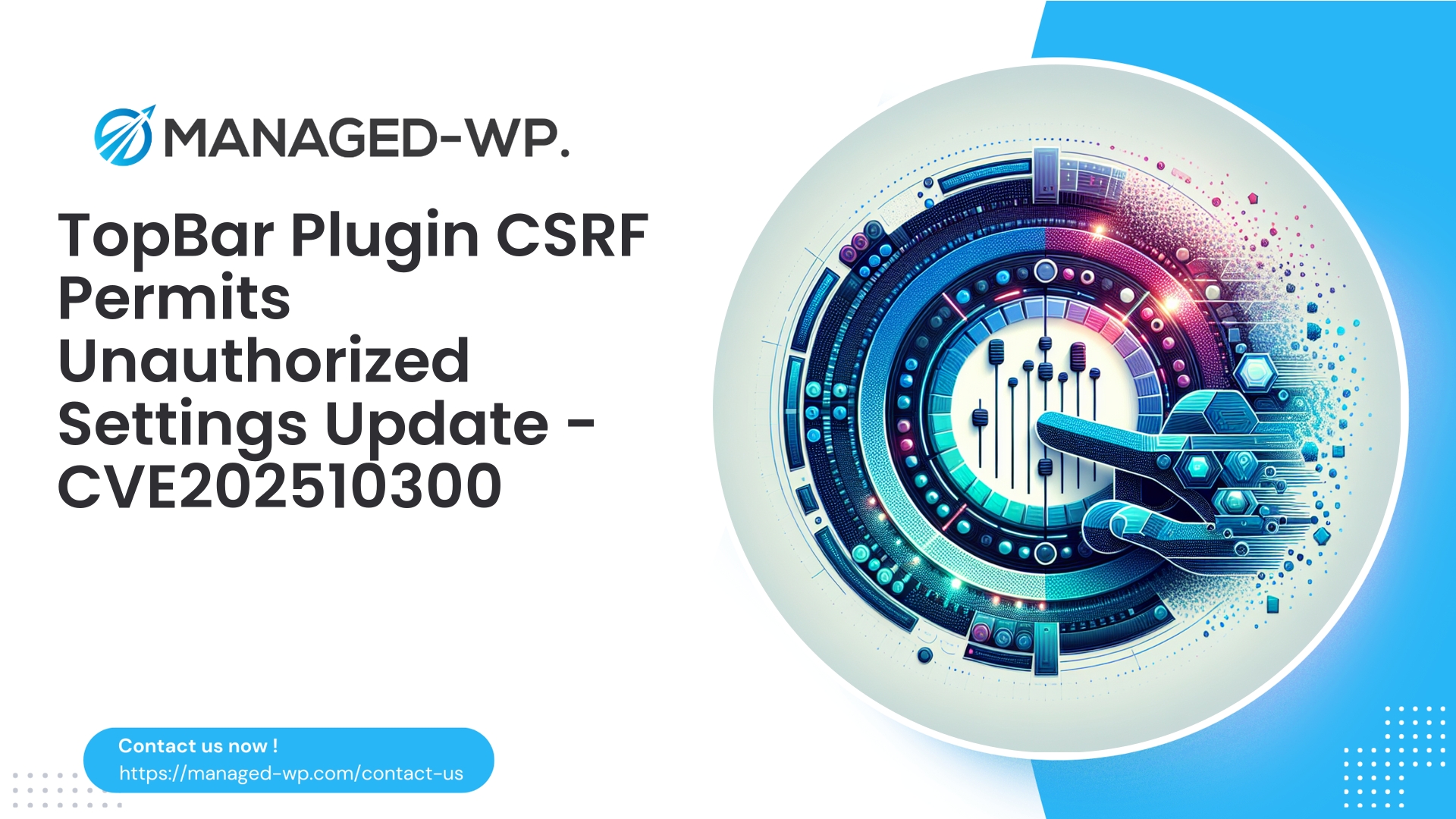| 插件名稱 | Ova Advent |
|---|---|
| 漏洞類型 | 已認證存儲型 XSS |
| CVE編號 | CVE-2025-8561 |
| 緊急 | 低的 |
| CVE 發布日期 | 2025-10-15 |
| 來源網址 | CVE-2025-8561 |
Ova Advent (≤1.1.7) — 透過短代碼的已認證貢獻者儲存型 XSS 漏洞:網站所有者必須了解的內容 (CVE-2025-8561)
作者: 託管 WordPress 安全團隊
日期: 2025-10-15
標籤: WordPress、外掛程式安全、XSS、WAF、事件回應
執行摘要
Ova Advent WordPress 外掛程式中發現了一個嚴重的安全漏洞,影響所有版本,包括 1.1.7 及更早版本。此經過驗證的儲存型跨站腳本 (XSS) 漏洞允許擁有「貢獻者」或更高權限的使用者保存精心建構的短代碼內容,這些內容未經適當清理便被渲染,從而導致腳本在網站訪問者的瀏覽器中持續執行。此漏洞的 CVE 編號為 CVE-2025-8561,於 2025 年 10 月 15 日發布,並在 1.1.8 版本中已修復。
使用 Ova Advent 外掛程式且允許貢獻者或更高權限使用者建立或編輯內容的網站,必須立即解決此漏洞。儲存型 XSS 漏洞與其他漏洞結合使用時,可導致多種危險的攻擊途徑,包括權限提升、未經授權的管理作業、惡意軟體傳播和帳戶劫持。
本文以清晰的技術術語詳細闡述了該漏洞,概述了檢測策略,提出了立即緩解措施,並解釋了 Managed-WP 的安全服務如何為無法立即應用更新的網站提供虛擬修補和保護。
筆記: 這份分析由美國安全專家以精準權威的方式呈現,重點在於可操作的防禦措施,而不會洩漏漏洞利用說明或敏感的攻擊方法。
了解漏洞
- 受影響的軟體: Ova Advent WordPress 插件,版本≤1.1.7
- 漏洞類型: 透過短代碼內容進行身份驗證的儲存型跨站腳本攻擊 (XSS)
- 所需使用者權限: 貢獻者角色或更高職位
- 已修復版本: 1.1.8
- 公共識別碼: CVE-2025-8561
簡要概述: 貢獻者可以儲存包含未轉義 HTML 或 JavaScript 的短程式碼資料。當這些資料顯示在頁面或文章中時,瀏覽器會執行其中嵌入的惡意腳本,從而影響所有造訪該內容的使用者。
網站所有者為何必須關注(實際影響)
儲存型跨站腳本攻擊 (XSS) 漏洞構成嚴重的安全威脅,因為惡意程式碼會持續存在於網站上,並影響所有瀏覽受感染內容的使用者。潛在後果包括:
- 劫持使用者會話或竊取 cookie(如果可以存取)
- 將使用者重新導向到攻擊者控制的網路釣魚或惡意軟體網站
- 視覺上的破壞或未經授權插入廣告
- 透過注入腳本載入外部有效載荷進行路過式惡意軟體感染
- 權限提升使攻擊者能夠在惡意腳本在特權會話中執行時以管理員權限行事。
- 透過修改內容或透過已驗證的請求建立管理員帳戶來建立持久性後門。
由於需要「貢獻者」層級的存取權限,該漏洞的利用範圍進一步擴大。 「貢獻者」角色通常授予客座作者或外部貢獻者,而他們往往受到網站管理員的信任。儘管 CVSS 基本評分為 6.5(中等),反映了身份驗證障礙,但在典型的 WordPress 環境中,其潛在危害仍然相當大。
漏洞技術概述
WordPress 短代碼允許外掛程式定義命名標籤,用於解析和顯示動態內容。通常,短代碼資料會儲存到資料庫中,然後在頁面渲染時輸出。
在這裡,Ova Advent 外掛程式未能對貢獻者輸入的短程式碼內容進行清理或轉義,就直接輸出,忽略了 WordPress 推薦的轉義函數,例如: esc_html(), esc_attr(), 或者 wp_kses()省略此設定後,可以透過事件處理程序屬性注入 JavaScript(例如, 滑鼠懸停)或惡意 tags.
當貢獻者創建的短程式碼內容對編輯、管理員或網站訪客可見時,攻擊是可行的,尤其是在已驗證身分的情況下發布或預覽貼文時。
常見攻擊場景
- 利用訪客作者帳號: 攻擊者獲取或建立貢獻者角色,並注入惡意短代碼內容,導致在內容預覽或即時頁面瀏覽期間執行隱藏腳本。
- 全域短程式碼持久化: 如果短代碼設定全域存在或在廣泛可存取的網站內容中持久存在,則每個訪客都會遇到注入的有效載荷。
- 針對管理員的攻擊: 腳本僅在管理員載入特定頁面時觸發,從而實現權限提升或資料外洩。
- 網路釣魚與重新導向: Javascript 有效載荷會導致靜默重定向或載入連接到攻擊者基礎架構的不可見框架。
檢測影響和利用
- 驗證插件版本:
- 登入 WordPress 管理後台 › 插件,確認 Ova Advent 版本是否 ≤ 1.1.7。
- 搜尋惡意短代碼內容:
- 檢查資料庫內容中是否存在短代碼(例如:
[ova_advent])包含可疑的 HTML 或腳本。
- 檢查資料庫內容中是否存在短代碼(例如:
- 執行目標資料庫查詢(事先備份):
- WP-CLI 搜尋範例:
wp post list --post_type=post,page --format=ids | xargs -n1 -I% wp post get % --field=post_content | grep -n "ova_advent\| - SQL 查詢(如有需要,請調整表格前綴):
SELECT ID, post_title FROM wp_posts WHERE post_content LIKE '%ova_advent%'; SELECT post_id, meta_key, meta_value FROM wp_postmeta WHERE meta_value LIKE '%ova_adventTP3Tuenames_peta_value_PPFtion_pp. WHERE option_value LIKE '%ova_advent%'; SELECT ID, post_title FROM wp_posts WHERE post_content REGEXP '
- WP-CLI 搜尋範例:
- 分析Web伺服器和應用程式日誌:
- 監控來自貢獻者帳戶的對 admin-ajax.php、post.php 或插件 REST 端點的 POST 請求,以發現可疑的有效負載。
- 留意針對非法請求的異常成功回應。
- 審查文件完整性:
- 檢查最近修改過的外掛程式和主題文件,是否存在註入或混淆的 JavaScript 程式碼。
- 注意行為指標:
- 瀏覽過程中出現意外重定向、彈出視窗或外部資源呼叫。
- 使用者報告稱某些頁面有異常網站行為。
立即採取的緩解措施
- 升級插件:
- 請盡快將 Ova Advent 更新至 1.1.8 或更高版本,以套用官方修補程式。
- 如果立即更新不可行:
- 暫時停用或卸載存在漏洞的插件。
- 從公開內容中移除短代碼實例。
- 暫時禁用短代碼處理程序
移除短代碼('ova_advent');在必須使用的外掛程式或主題 functions.php 檔案中。 - 使用清理程式碼片段(見下文)實現輸出過濾,以消除儲存的短程式碼中的危險程式碼。
- 限制貢獻者權限:
- 在網站安全得到保障之前,暫時撤銷或限制貢獻者帳號。
- 發佈內容前需經編輯或管理員批准。
- 進行場地清理和掃描:
- 識別並移除嵌入內容中的惡意腳本或屬性。
- 除了人工檢查外,還要使用信譽良好的惡意軟體掃描程式。
- 更改憑證和輪換密鑰:
- 如果懷疑存在入侵行為,則強制重設特權帳戶的密碼。
- 根據需要輪換 API 金鑰和資料庫密碼。
- 為事件響應保留證據:
- 在進行永久性變更之前,請匯出受影響的內容和日誌以進行取證檢查。
臨時加固程式碼範例(WordPress)
將以下 PHP 程式碼片段新增至 MU 外掛程式或網站特定外掛程式。此程式碼可清理短程式碼輸出,去除危險的標籤和屬性,作為外掛程式更新前的臨時解決方案。務必在生產環境部署前先在測試環境中進行測試。
<?php
/**
* Temporary mitigation: sanitize Ova Advent shortcode output.
* Save as mu-plugins/shortcode-sanitize.php or similar.
*/
add_filter('do_shortcode_tag', function($output, $tag, $attr) {
if ($tag !== 'ova_advent') {
return $output;
}
$allowed_tags = array(
'a' => array('href' => true, 'title' => true, 'rel' => true),
'p' => array(),
'br' => array(),
'strong' => array(),
'em' => array(),
'ul' => array(),
'ol' => array(),
'li' => array(),
'img' => array('src' => true, 'alt' => true, 'width' => true, 'height' => true),
);
// Remove event handlers and javascript URIs
$output = preg_replace('#(<[a-zA-Z]+\\s[^>]*)(on[a-zA-Z]+\\s*=\\s*["\'][^"\']*["\'])([^>]*>)#i', '$1$3', $output);
$output = str_ireplace('javascript:', '', $output);
$output = str_ireplace('data:text/html', '', $output);
return wp_kses($output, $allowed_tags);
}, 10, 3);
- 這種方法具有局限性,只能作為一種臨時保護措施。
- 務必在測試環境中進行驗證,然後再投入實際使用。
託管式 WordPress Web 應用程式防火牆 (WAF) 的優勢
我們的託管式WP WAF除了修補程式之外,還增加了其他重要的保護措施:
- 虛擬補丁:
- 快速部署規則,阻止HTTP請求等級的攻擊嘗試,無需立即更新外掛程式。
- 阻止惡意貢獻者發送的包含 XSS 模式和混淆的短代碼有效載荷。
- 請求檢查和阻止:
- 監控對管理端點的 POST 請求,過濾或拒絕可疑的有效負載欄位。
- 實施速率限制,阻止高風險帳戶創建或登入濫用行為。
- 即時警報與監控:
- 讓網站所有者了解偵測到的攻擊和可疑活動,以便及時做出回應。
- 低誤報率策略:
- 透過考慮使用者角色和上下文,調整規則以最大限度地減少干擾。
WAF概念邏輯範例:
- 封鎖來自具有「貢獻者」或更低角色的已認證使用者的 POST 請求,這些請求應包含可疑字串,例如:
<script,on[az]=,javascript:或包含短代碼名稱的編碼有效載荷。
Managed-WP 客戶會在我們的服務框架內自動獲得這些保護,從而及時關閉漏洞暴露視窗。
事件回應工作流程
- 隔離:
- 如果發現惡意行為,請將網站置於維護模式。
- 停用或移除存在漏洞的插件,並停用短代碼。
- 包含:
- 撤銷或停用可疑的貢獻者帳號。
- 應用短代碼清理並啟用虛擬補丁。
- 確認:
- 從資料庫表和日誌中提取並分析可疑內容。
- 記錄攻擊者的 IP 位址和行為模式。
- 根除:
- 從資料庫和檔案中清除惡意負載。
- 恢復已知良好的備份並修補所有易受攻擊的組件。
- 輪換所有敏感憑證和密鑰。
- 恢復:
- 恢復網站正常運行,並加強監控。
- 監控日誌和警報,以防再次感染。
- 學習與磨練:
- 建立事件時間軸和報告,記錄事件經過。
- 改進使用者角色、新使用者引導和插件更新策略。
- 考慮使用自動化工具來加快未來的漏洞管理速度。
其他加固建議
- 應用最小權限原則: 避免將投稿者權限分配給不受信任的使用者;最好使用經過安全處理的訪客發文表單。
- 強制執行內容清理: 確保 WordPress 功能
未過濾的 HTML受到限制,並且在適當情況下啟用基於 KSES 的過濾。 - 實施編輯審核: 要求編輯或管理員在發布投稿人提交的內容之前對其進行審核。
- 在開發過程中對所有使用者提供的資料進行減敏處理: 使用轉義函數,例如
esc_html(),esc_attr(),esc_url(), 和wp_kses()在外掛程式和主題程式碼中嚴格執行。 - 短代碼安全最佳實踐: 對輸入中的所有短代碼屬性進行驗證和清理,並對輸出進行一致的轉義。
- 保持插件更新: 定期維護並移除不活躍的插件。
- 使用安全插件和WAF: 利用託管安全服務提供虛擬修補程式和快速回應能力。
安全移除惡意儲存的有效載荷
請依照以下謹慎步驟清除注入的 XSS 痕跡:
- 匯出可疑貼文或元資料行,用於備份和取證目的。
- 審核內容,區分惡意資料和合法資料。
- 手動取代或刪除惡意 HTML 片段。
- 如果可以,請考慮從感染前的備份中恢復受影響的頁面/貼文。
檢測範例 SQL 查詢(唯讀):
-- 尋找可能注入了腳本或事件處理程序的帖子 SELECT ID, post_title, post_author, post_date FROM wp_posts WHERE post_content REGEXP '
清潔後,徹底掃描您的場地並監控是否再次發生,以確保控制疫情。
即使緊急程度“低”,您也應該優先考慮此漏洞
低嚴重性評級通常低估了實際操作風險。此漏洞對以下情況特別關鍵:
- 接受外部投稿的多作者博客
- 社區或訪客發文環境
- 編輯/管理員定期預覽或發布投稿人提交內容的網站,為攻擊者提供了提升權限的途徑。
在這些情況下,任何涉及內容渲染插件的儲存型 XSS 漏洞都必須受到高度重視,以避免被利用。
Managed-WP 如何保護您的網站
Managed-WP 結合了多個專家層來強化您的 WordPress 環境:
- 針對新威脅,快速部署了受管 WAF 規則
- 虛擬補丁阻止應用程式邊緣的漏洞利用
- 基於上下文的保護,考慮使用者角色和請求參數,以最大限度地減少誤報
- 自動化惡意軟體掃描和清理選項,以實現全面的安全防護。
- 主動預警與專家指導,助您高效應對攻擊
如果您無法立即更新或尋求持續保護,Managed-WP 可透過最大限度地減少風險並提供快速事件回應工具來讓您安心。
Managed-WP Protection 入門指南
試試 Managed-WP Basic — 每個 WordPress 網站的基本安全保障
您無需企業級資源即可有效保護您的網站。 Managed-WP Basic(免費套餐)提供託管防火牆、應用程式級 WAF、惡意軟體掃描以及針對常見 OWASP Top 10 威脅(包括 XSS)的防禦。如果您擔心 CVE-2025-8561 或其他外掛程式漏洞,這款便利的解決方案可在您安排更新時提供至關重要的保護層。
了解更多並註冊: https://my.wp-firewall.com/buy/wp-firewall-free-plan/
升級至標準版或專業版可解鎖自動惡意軟體清除、IP 允許/封鎖清單、定時報告和自動虛擬修補功能。
常見問題解答
Q:升級到 1.1.8 版本後,還需要掃描嗎?
答:當然。此次更新可以防止新的漏洞注入,但資料庫中已存在的惡意內容仍然存在,必須對其進行識別和刪除。
Q:僅透過日誌能否偵測到此漏洞?
答:日誌可以提供補充線索,但對短代碼內容的資料庫檢查可以提供最確鑿的檢測結果。
Q:禁用短代碼執行是否能消除所有風險?
答:它能阻止程式執行,但無法清除有害的儲存資料。禁用短代碼只能部分緩解問題;清理和修補仍然至關重要。
Q:何時應該實施WAF虛擬補丁?
答:一旦發現漏洞,在您進行更新之前,虛擬修補程式就能在防火牆層面阻止攻擊,為您爭取寶貴的修復時間。
WordPress網站所有者的實用後續步驟
- 立即驗證並升級 Ova Advent 至 1.1.8 版本。
- 如果無法立即升級:
- 停用外掛程式或停用短代碼輸出。
- 應用提供的短代碼清理 MU 插件。
- 限制貢獻者權限,直至安全狀況恢復。
- 啟用針對此漏洞自訂的託管 WP WAF 保護。
- 對資料庫中的惡意腳本或有效載荷進行全面掃描,並根據需要進行清理。
- 輪換所有相關密碼,並審核使用者帳戶是否有未經授權的存取。
- 監控日誌和警報,以發現持續的攻擊嘗試,並考慮持續進行託管虛擬修補程式。
參考文獻及延伸閱讀
如需專業協助,Managed-WP 安全團隊可以為您提供以下服務:
- 請確認您的網站是否受到影響。
- 應用自訂虛擬補丁和WAF規則以立即提供保護
- 執行有針對性的資料庫掃描,以偵測儲存的惡意負載。
- 支援安全的內容清理和事後持續監控
立即使用 Managed-WP 保護您的 WordPress 網站: https://my.wp-firewall.com/buy/wp-firewall-free-plan/



















